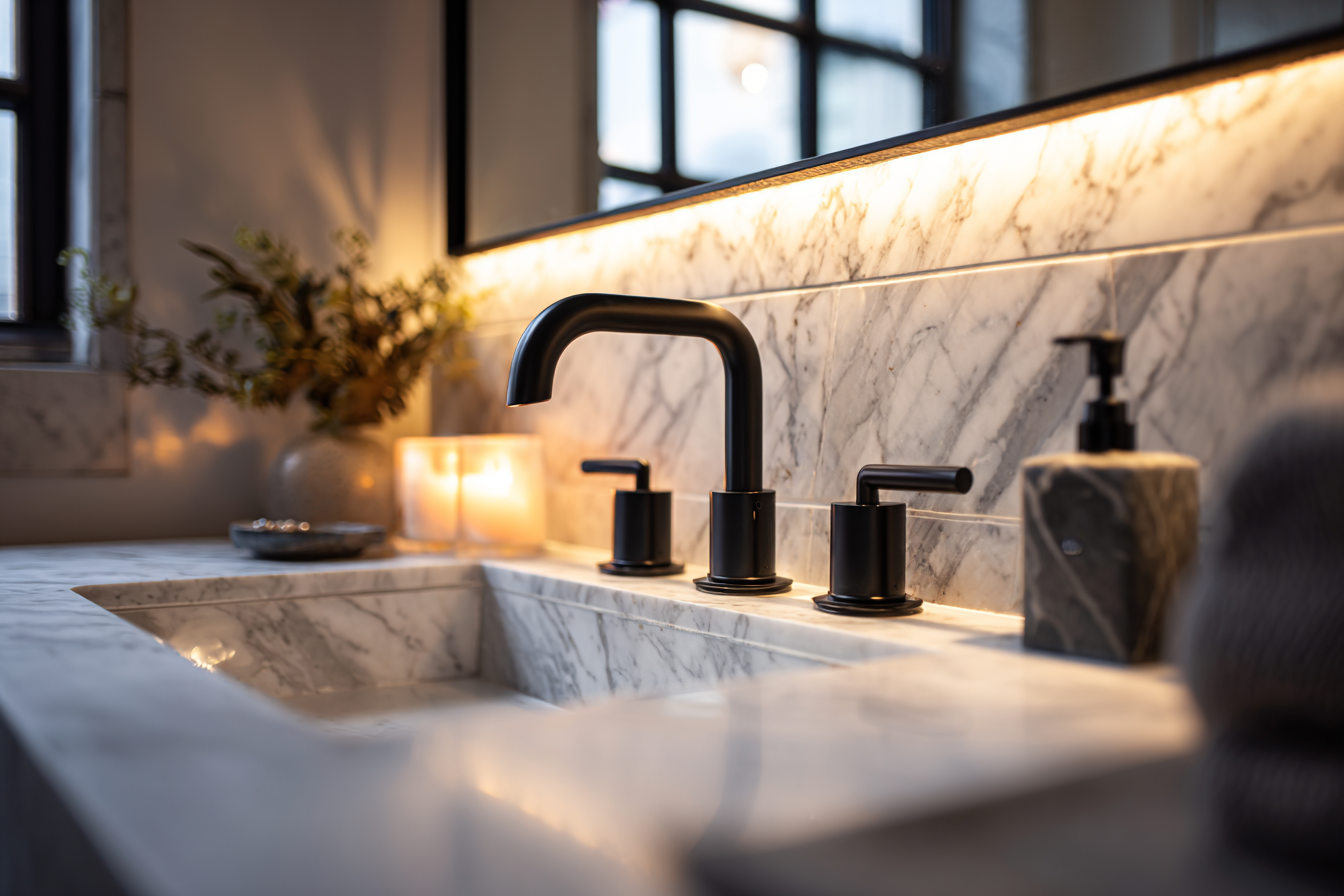It’s often the small things that cause the biggest headaches. A hairline crack in a pipe under the sink, a slow drip behind the fridge, or a faulty valve near the water heater can go unnoticed for weeks. By the time the problem is discovered, you might be staring at damaged flooring, swollen cabinetry, or even mold growth. This is where smart plumbing steps in, blending technology with the everyday essentials of home life.
Smart systems don’t just protect your home from water damage. They give you peace of mind, save money on bills, and help keep your space comfortable and stylish without feeling cluttered by gadgets. The result is a home that runs smoothly in the background so you can enjoy living in it.
What Smart Plumbing Really Means
When people hear “smart plumbing,” they sometimes imagine a futuristic home with complicated tech. In reality, it’s about simple tools that quietly work for you.
- Leak sensors: Small, battery-powered devices placed near appliances or pipes.
- Whole-home monitors: Devices installed on the main line that analyze flow and pressure.
- Automatic shutoff valves: Systems that close the water line when a leak is detected.
- Smart fixtures: Faucets, toilets, and showers that save water and enhance convenience.
- Dashboards and apps: Interfaces that track usage and send alerts directly to your phone.
Most systems are designed to integrate with platforms like Alexa, Google Assistant, or Apple HomeKit. They don’t demand a remodel either, since many retrofit easily into existing setups, making them accessible for both homeowners and renters.
Everyday Problems Smart Plumbing Solves
The appeal of smart plumbing goes beyond gadgets. It’s about solving real homeowner frustrations:
Water Damage Prevention
Leaks don’t wait until it’s convenient. A smart valve paired with sensors can stop the main water line instantly when trouble arises, preventing thousands of dollars in damage.
Lower Bills and Water Savings
Analytics reveal patterns you may not notice, like a toilet that runs at night or irrigation leaks that spike water usage. Fixing these quickly saves both money and resources.
Convenience and Comfort
Want to warm up your shower before stepping in? Or check your water usage while traveling? With app integration, these little comforts are now everyday possibilities.
Insurance Benefits
Some insurers even provide discounts for homes with automatic shutoff valves, rewarding proactive protection.
Choosing the Right Hardware
Leak Sensors
The first step is often the simplest: place leak sensors where issues are most likely to occur—under sinks, behind the fridge, around the water heater, and near laundry machines.
Whole-Home Monitors
These advanced systems track water flow, identifying anomalies that point to hidden leaks. They can even flag micro-leaks that traditional methods miss.
Auto-Shutoff Valves
Think of these as the backbone of a smart system. Once paired with sensors, they can close the main water line in seconds. Today’s models are small, discreet, and often DIY-friendly.
Smart Plumbing in Different Homes
Not every setup is the same, but options exist for everyone.
- Renters and condo owners can start with portable sensors and clip-on valves.
- Single-family homes may benefit from a pre-installed inline shutoff system for full coverage.
- Renovations and new builds present opportunities to integrate recirculation pumps or smart manifolds directly into the design.
The flexibility ensures smart plumbing is not only for new luxury builds but also for everyday households.

Design and Utility in Harmony
Homeowners who care about aesthetics don’t need to compromise. Many smart fixtures come in finishes like brushed brass, matte black, or polished chrome. These elevate the look of a bathroom or kitchen while bringing touchless operation or thermostatic controls.
The technology that drives sensors and hubs can be hidden in utility closets or tucked beneath cabinetry. With thoughtful placement, you preserve the beauty of your interiors while gaining the benefits of smart functionality.
Room-by-Room Smart Plumbing Checklist
A practical approach for coverage:
Start in the kitchen with sensors under sinks, near the dishwasher, and by the refrigerator line. In bathrooms, place them under vanities and behind toilets while considering touchless faucets. The laundry room needs coverage in the washer pan, and some models also track vibration. Don’t forget mechanical areas like the water heater pan and sump pump zones. For outdoor spaces, keep an eye on irrigation systems or crawlspaces prone to leaks.
This covers your entire home systematically.
When to DIY and When to Call a Pro
Some smart plumbing tools are designed with simplicity in mind. Battery-powered leak sensors and app-based hubs are often plug-and-play. However, certain jobs require expertise:
- Installing inline shutoff valves
- Adjusting water pressure regulators
- Detecting and repairing slab or hidden leaks
- Integrating smart systems with existing plumbing infrastructure
Working with a qualified local plumber ensures these complex installations meet code requirements and perform reliably. Professionals have specialized tools to locate problems that sensors only flag, and they understand how to integrate new technology with older plumbing systems safely.
Costs, Subscriptions, and Compatibility
Smart plumbing costs can vary widely:
- Sensors: $50–$100 each
- Whole-home monitors: $200–$400
- Shutoff valves: $400–$900+
Some systems charge monthly fees for advanced features like detailed analytics or extended history logs. Compatibility is another key consideration. The industry is shifting toward Matter, a universal standard that allows devices to communicate across platforms, giving homeowners flexibility and futureproofing.
Data That Actually Matters
Dashboards provide more than numbers. They let you set thresholds, such as alerts if water runs overnight or if flow continues when no one is home. This practical data turns into measurable savings, like spotting a toilet that wastes gallons per day or identifying irrigation inefficiencies.
Real-Life Scenarios
Vacation Protection
You’re out of town and a pipe bursts. Instead of coming home to disaster, your system shuts off water and sends an alert to your phone.
The Mystery Bill
A spike in your water bill could be a hidden leak. Flow analytics quickly point to the problem, saving weeks of guesswork.
A Bathroom Upgrade
Stylish fixtures with touchless operation and preset temperatures transform the space into a modern retreat while conserving resources.
Maintenance and Testing
Like any system, smart plumbing needs upkeep:
- Test sensors quarterly with a damp cloth.
- Replace batteries annually.
- Exercise valves to keep them moving freely.
- Ensure Wi-Fi reaches all devices, including crawlspaces and garages.
These simple tasks extend the life of the system and keep it reliable.
Codes, Insurance, and Warranties
Some cities require professional installation for shutoff valves or backflow devices. Checking local code avoids compliance issues. On the insurance side, homeowners may qualify for premium discounts by installing water safety devices.
How to Vet a Professional
Not all plumbers are equally experienced with smart systems. When choosing, look for:
- Proper licensing and insurance
- References from past clients
- Familiarity with your brand of system
- Ability to plan a clean, discreet installation
According to Caswell Plumbing & Heating, homeowners should verify that their plumber has experience with both traditional systems and modern smart technology integration. Licensed professionals ensure installations meet local code requirements while planning discreet placements that preserve your home’s aesthetics.
Quick Buyer’s Matrix
| Use-Case | Core Device | DIY or Pro | Approx. Cost | Aesthetic Impact |
|---|---|---|---|---|
| Apartment/Condo | Portable sensors | DIY | $50–$150 | Hidden |
| Large Home | Inline shutoff valve | Pro | $500–$900 | Minimal |
| Frequent Traveler | Whole-home monitor | Pro/DIY | $300–$600 | None visible |
| Budget Build | Starter kit (3 sensors + hub) | DIY | $150–$250 | Hidden |
Smarter Water, Calmer Home
Smart plumbing isn’t about filling your house with gadgets. It’s about creating a home that looks beautiful, runs smoothly, and protects itself from costly mishaps. By combining thoughtful design with the latest technology, homeowners can achieve both style and peace of mind.
Start small with a few sensors, and as your needs grow, expand into whole-home protection. And when the project calls for professional expertise, you know where to turn.

